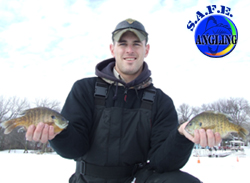 Selective harvest practices based on a real understanding of the specific fishery, and strictly obeying all fish and game laws.
SAFE Angling Practice #2:
Selective harvest practices based on a real understanding of the specific fishery, and strictly obeying all fish and game laws.
SAFE Angling Practice #2:Fisheries management and DNR officials work to maintain a balance of fish as they relate to habitat, other fish and wildlife to create a strong, healthy fishery. Creel limits and size limits and slots are designed to maintain balance and create a strong and attractive fishery for anglers. Anglers disregarding these rules disturb the balance and undermine a plan designed to benefit them, other anglers, and fish as well. In a very basic sense, the idea of selective harvest is "limiting our catch, not catching our limit". By catching and keeping fish enough for one meal (as a rule of thumb), a balance can still be maintained within a given body of water in regard to the ecosystem. This often means keeping far less than is allowable by law. Ethics and laws are not always one-for-one. That is, what is legal is not always what it ethical, and taking a personal stake in responsible harvest may mean harvesting less than would be legal. Catching and keeping an excessive number of fish can deplete the fish population, and harm the fishery over very little time in instances. The best choice is to keep fast-reproducing species like panfish, under-utilized or invasive species like carp or yellow bass, or harvesting from put-and-take fisheries like stocked rainbow trout. If keeping popular sportfish such as walleye, bass or pike, a few mid-sized fish is best, letting smaller fish grow and reproduce, and larger fish go to keep large genetics in the system.

